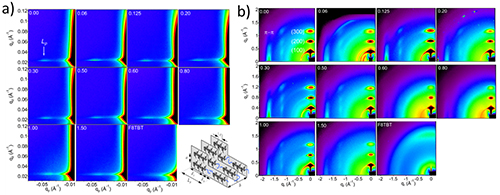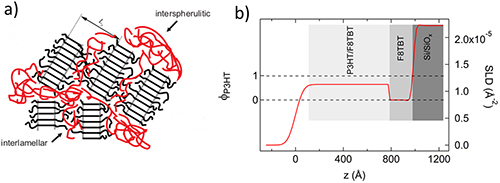X-RAY RUNS: Apply for Beamtime
2017 Nov 1 - Dec 21
2018 Feb 7 - Apr 3
2018 Proposal/BTR deadline: 12/1/17
2018 Apr 11 - Jun 4
2018 Proposal/BTR deadline: 2/1/18
Bulk hetero junctions (BHJ) constitute a promising route for low-cost solar cells based on semiconducting polymers. The crucial property of a BHJ is a self-organized interspersed network of donor and acceptor materials that transport the charge produced by the absorption of sunlight to the respective electrodes. In semiconducting molecules and polymers the charge splitting works via a bound electron-hole pair, a so-called exciton. The exciton has a finite lifetime corresponding to a diffusion length of only 10 nm, before it recombines, and thus the exciton has to reach a donor-acceptor interface within this range; otherwise it will not contribute to the photo current.
A well-studied example of a BHJ is P3HT/PCBM. P3HT (poly(3-hexylthiophene)) is a semiconducting polymer with a thiophene backbone and alkyl side chains. PCBM ([6,6]-phenyl-C61-butyric acid methyl ester) is a derivatized bucky ball which forms small amorphous domains within the P3HT network. The challenge is to find the right processing conditions to achieve the optimum nanostructure. So far P3HT/PCBM solar cells have been limited to an efficiency of few percent and are thus are a far cry from efficiencies of ~20% routinely achieved with crystalline silicon.
Recently the organic electronics group at Cambridge University, UK led by Prof. Ullrich Steiner and Prof. Richard Friend, investigated a different BHJ device: instead of using the combination of a polymer and a small molecule, as done in P3HT/PCBM, they explored an all-polymer blend. F8TBT (poly[(9,9-dioctyluorene)-2,7-diyl-alt-(4,7-bis(3-hexylthien-5-yl)-2,1, 3-benzothiadiazole)-2′,2″-diyl]) is an amorphous (or weakly aggregating) polymer, as opposed to the strongly crystallizing P3HT. The P3HT used in this study was synthetized in-house and had a nearly defect-free regioregular chain structure. This allowed monitoring the semi-crystalline P3HT morphology in an all-polymer blend system.
Dr. Alessandro Sepe, leader of the x-ray scattering group, studied a systematic sample series of different P3HT/F8TBT compositions at CHESS D1 station, using a combination of GISAXS and GIWAXS. While GIWAXS probes the P3HT crystal unit cell, GISAXS probes the self-organized nanostructure of the semi-crystalline P3HT lamellar morphology. The findings were recently published in the Royal Society of Chemistry journal “Energy & Environmental Science” [1].

Figure 1. (a) 2D GISAXS maps of P3HT/F8TBT films, as a function of F8TBT loading, showing the changes in the P3HT semi-crystalline lamellar morphology, i.e. the long-period (Lp), as highlighted by its scattering signal. The inset shows a schematic of the semi-crystalline structure of P3HT. a, b and c represent the crystal lattice constants; Lp is the periodicity of the alternating crystal and amorphous lamellae. (b) Corresponding 2D GIWAXS maps, showing the characteristic P3HT crystal structure, which is unchanged upon F8TBT loading.
In addition x-ray reflectivity unveiled that F8TBT forms a 20 nm thick hole-blocking layer at the electrode, thus identifying one of the crucial aspects decreasing the efficiency of P3HT/F8TBT devices. Therefore this study identified a clear pathway to the design of future high-efficiency all-polymer solar cells.

Figure 2. (a) Sketch illustrating the top view of P3HT/F8TBT structure formation, with F8TBT (red) segregating into P3HT (black) interlamellar spaces and to the boundaries of P3HT crystallites. (b) Corresponding X-ray reflectivity model of the XR data collected at D1 showing F8TBT segregation at the substrate interface.
A crucial feature of CHESS D1 station for this research project was that measurements with all three scattering techniques could be performed at the same station.
The strong tendency towards crystallization of P3HT provides the structure-forming motif that determines the performance of BHJ-style devices. It creates an interdigitated binary morphology on the 10 nm scale that is embedded in a mesoscopic network of the acceptor phase. The present study shows that this principle, previously ascribed to the P3HT/PCBM couple, also extends to all-polymer photovoltaic blends. The combination of a strongly crystallizing polymer with one that only weakly aggregates, and good compatibility of the two components has elucidated one of the fundamental mechanisms that is indispensable for the further development of organic electronic devices, paving the way for further synthetic modifications of homopolymers as well as blend systems.
References:
[1] A. Sepe, Z. Rong, M. Sommer, Y. Vaynzof, X. Sheng, P. Müller-Buschbaum, D. Smilgies, Z. Tan, L. Yang, R. Friend, U. Steiner and S. Hüttner: "Structure Formation in P3HT/F8TBT Blends", Energy Environ. Sci., on-line DOI: 10.1039/c3ee44125c.
Submitted by: Detlef Smilgies, CHESS, Cornell University
and Alessandro Sepe, University of Cambridge, UK
04/10/2014
